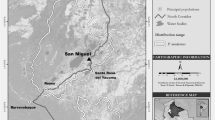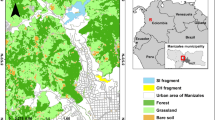Abstract
A 17-month study was made of the primates using a 9-ha “island” of forest, surrounded by savanna, in the northern part of the Lopé Reserve, Gabon. One group ofCercopithecus cephus (plus a young maleCercopithecus nictitans who was in permanent association with them) were resident in the fragment and groups of five other species of primates made visits during 127 days of observation:Pan troglodytes, 15 visits;Cercocebus albigena, 10;Colobus satanas, 3;Cercopithecus nictitans, 2;C. pogonias, 1. Visits were also made by lone males of three species,C. nictitans, Cercocebus albigena, andMandrillus sphinx. The eighth species of diurnal primate present at Lopé,Gorilla g. gorilla, did not visit the fragment during the study. Compared to conspecific groups in neighbouring continuous forest, primates in the fragment ate less fruit, seeds and flowers and more insects and leaves. The local population density of primates resident in the fragment was equivalent to that of the neighbouring continuous forest where all eight species occur, despite the diversity and abundance of fruit being less in the fragment. The costs imposed on the resident group by the reduced diversity and availability of preferred fruit foods appeared to be offset by a number of benefits that increased individual feeding efficiency for monkeys residing within a single fragment. These included lower travel costs, reduced feeding competition between individuals through group fission, and excellent knowledge of the location and quality of food resources in the small home range. It is also possible that the overall negative impact of inter-specific feeding competition was lower in fragments than in continuous forest and that micro-habitat differences resulted in an increased availability of palatable insect and leaf fallback foods in the fragment.
Similar content being viewed by others
References
Buchanan-Smith, H. M. 1999. Tamarin polyspecific associations: forest utilization and stability of mixed-species groups.Primates, 40: 233–247.
Butynski, T. M. 1990. Comparative ecology of blue monkeys (Cercopithecus mitis) in high- and lowdensity subpopulations.Ecol. Monogr., 60: 1–26.
Chapman, C. 1987. Flexibility in diets of three species of Costa Rican primates.Folia Primatol., 49: 90–105.
Chapman, C. A.;Chapman, L. J. 1996. Mixed-species primate, groups in the Kibale Forest: ecological constraints on association.Int. J. Primatol., 17: 31–50.
Chapman, C. A.;Chapman, L. J. 1999. Implications of small scale variation in ecological conditions for the diet and density of red colobus monkeys.Primates, 40: 215–231.
Chapman, C. A.;Wrangham, R. W.;Chapman, L. J. 1995. Ecological constraints on group size: an analysis of spider monkey and chimpanzee subgroups.Behav. Ecol. Sociobiol., 36: 59–70.
Eisenberg, J. F.;Thorington, R. W. J. 1973. A preliminary analysis of a neotropical mammal fauna.Biotropica, 5: 150–161.
Garber, P. A. 1989. Role of spatial memory in primate foraging patterns:Saguinus mystax andSaguinus fuscicollis.Amer. J. Primatol., 19: 203–216.
Gautier-Hion, A. 1980. Seasonal variation of diet related to species and sex in a community ofCercopithecus monkeys.J. Anim. Ecol., 49: 237–269.
Gautier-Hion, A. 1988. Polyspecific associations among forest guenons: ecological, behavioural and evolutionary aspects. In:A Primate Radiation: Evolutionary Biology of the African Guenons,Gautier-Hion,A.;Bourlière,F.;Gautier,J. P.;Kingdon,J. (eds.), Cambridge Univ. Press, Cambridge, pp. 452–476.
Gautier-Hion, A.;Duplantier, J. M.;Quris, R.;Feer, F.;Sourd, C.;Decoux, J. P.;Dubost, G.;Emmons, L. H.;Erard, C.;Hecketsweiler, P.;Moungazi, A.;Roussilhon, C.;Thiollay, J. M. 1985. Fruit characters as a basis of fruit choice and seed dispersal in a tropical forest community.Oecologia, 65: 324–337.
Gautier-Hion, A.;Emmons, L. H.;Dubost, G. 1980. A comparison of the diets of three major groups of primary consumers of Gabon (primates, squirrels, and rodents).Oecologia, 45: 182–189.
Gautier-Hion, A.;Gautier, J. P.;Moungazi, A. 1997. Do black colobus in mixed-species groups benefit from increased foraging efficiency?Comptes Rendu de l'Academie des Sci. de Paris, 320: 67–71.
Gautier-Hion, A.;Michaloud, G. 1989. Are figs always keystone resources for tropical frugivorous vertebrates?: a test in Gabon.Ecology, 70: 1826–1833.
Gautier-Hion, A.;Quiris, R.;Gautier, J. P. 1983. Monospecific vs polyspecific life: a comparative study of foraging and antipredatory tactics in a community ofCercopithecus monkeys.Behav. Ecol. Sociobiol., 12: 325–335.
Jeffries, M. J.;Lawton, J. H. 1984. Enemy free space and the structure of ecological communities.Biol. J. Linn. Soc., 23: 269–286.
Leighton, M.;Leighton, D. R. 1983. Vertebrate response to fruiting seasonality within a Bornean rain forest. In:Tropical Rain Forest Ecology and Management,Sutton,S. L.;Whitmore,T. C.;Chadwick,A. C. (eds.), Blackwell Sci., London, pp. 181–196.
MacKinnon, J. R.;MacKinnon, K. S. 1980. Niche differentiation in a primate community. In:Malayan Forest Primates: Ten Year's Study in Tropical Rain Forest,Chivers,D. J. (ed.), Plenum Press, New York, pp. 167–190.
Peres, C. A. 1993. Anti-predation benefits in a mixed-species group of Amazonian tamarins.Folia Primatol., 61: 61–76.
Rogers, M. E.;Abernethy, K. A.;Fontaine, B.;Wickings, E. J.;White, L. J. T.;Tutin, C. E. G. 1996. Ten days in the life of a mandrill horde in the Lopé Reserve, Gabon.Amer. J. Primatol., 40: 297–313.
Rogers, M. E.;Maisels, F.;Williamson, E. A.;Fernandez, M.;Tutin, C. E. G. 1990. Gorilla diet in the Lopé Reserve, Gabon: a nutritional analysis.Oecologia, 84: 326–339.
Terborgh, J. 1983.Five New World Primates. Princeton Univ. Press, Princeton, New Jersey.
Terborgh, J. 1986a. Community aspects of frugivory in tropical forests. In:Frugivores and Seed Dispersal,Estrada,A.;Fleming,T. H. (eds.), Dr. W. Junk Publ., Dordrecht, pp. 371–384.
Terborgh, J. 1986b. Keystone plant resources in the tropical forest. In:Conservation Biology: The Science of Scarcity and Diversity,Soule,M. E. (ed.), Sinauer Associates, Sunderland, Massachusetts, pp. 330–344.
Terborgh, J.;Janson, C. H. 1986. The socioecology of primate groups.Ann. Rev. Ecol. System., 17: 111–135.
Tutin, C. E. G. 1996. Ranging and social structure of lowland gorillas in the Lopé Reserve, Gabon. In:Great Ape Societies,McGrew,W. C.;Marchant,L. F.;Nishida,T. (eds.), Cambridge Univ. Press, Cambridge, pp. 58–70.
Tutin, C. E. G.;Fernandez, M. 1993a. Composition of the diet of chimpanzees and comparisons with that of sympatric lowland gorillas in the Lopé Reserve, Gabon.Amer. J. Primatol., 30: 195–211.
Tutin, C. E. G.;Fernandez, M. 1993b. Relationships between minimum temperature and fruit production in some tropical forest trees in Gabon.J. Trop. Ecol., 9: 241–248.
Tutin, C. E. G.;Fernandez, M.;Rogers, M. E.;Williamson, E. A.;McGrew, W. C. 1991. Foraging profiles of sympatric lowland gorillas and chimpanzees in the Lopé Reserve, Gabon.Phil. Trans. R. Soc. Lond., B334: 179–186.
Tutin, C. E. G.; Ham, R. M.; White, L. J. T.; Harrison, M. J. S. 1997a. The primate community of the Lopé Reserve, Gabon: diets, responses to fruit scarcity and effects on biomass.Amer. J. Primatol., 42: 1–24.
Tutin, C. E. G.;White, L. J. T.;Mackanga-Missandzou, A. 1997b. The use by rain forest mammals of natural forest fragments in an equatorial African savanna.Conserv. Biol., 11: 1190–1203.
Tutin, C. E. G.;White, L. J. T.;Williamson, E. A.;Fernandez, M.;McPherson, G. 1994. List of plant species identified in the northern part of the Lopé Reserve, Gabon.Tropics, 3: 249–276.
Wallace, A.;Farrow, M. 1987. On detecting interactions between species in population dynamics.Biol. J. Linn. Soc., 32: 271–279.
Waser, P. M. 1987. Interactions among primate species. In:Primate Societies,Smuts,B. B.;Cheney,D. L.;Seyfarth,R. M.;Wrangham,R. W.;Struhsaker,T. T. (eds.), The Univ. of Chicago Press, Chicago, pp. 210–226.
White, L. J. T. 1994. Biomass of rain forest mammals in the Lopé Reserve, Gabon.J. Anim. Ecol., 63: 499–512.
White, L. J. T. in press. Forest-savanna dynamics and the origins of ‘Marantaceae Forest’ in the Lopé Reserve, Gabon. In:African Rain Forest Ecology and Conservation,Weber, B.; Vedder, A.; Simons-Morland, H.; White, L. J. T. (eds.), Yale Univ. Press, New Haven.
Williamson, E. A.;Tutin, C. E. G.;Rogers, M. E.;Fernandez, M. 1990. Composition of the diet of lowland gorillas at Lopé in Gabon.Amer. J. Primatol., 21: 265–277.
Wrangham, R. W.;Chapman, C. A.;Clark-Arcadi, A. P.;Isabirye-Basuta, G. 1996. Social ecology of Kanyawara chimpanzee: implications for understanding the costs of great ape groups. In:Great Ape Societies,McGrew,W. C.;Marchant,L. F.;Nishida,T. (eds.), Cambridge Univ. Press, Cambridge, pp. 48–57.
Wrangham, R. W.;Gittleman, J. L.;Chapman, C. A. 1993. Constraints on group size in primates and carnivores: population density and day range as assays of exploitation competition.Behav. Ecol. Sociobiol., 32: 199–209.
Author information
Authors and Affiliations
About this article
Cite this article
Tutin, C.E.G. Fragmented living: Behavioural ecology of primates in a forest fragment in the Lopé Reserve, Gabon. Primates 40, 249–265 (1999). https://doi.org/10.1007/BF02557714
Received:
Accepted:
Issue Date:
DOI: https://doi.org/10.1007/BF02557714




